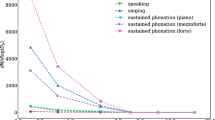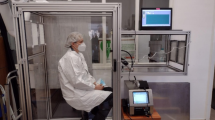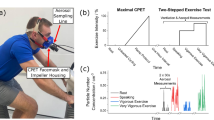Abstract
Objective
To elucidate the role of phonation frequency (i.e., pitch) and intensity of speech on respiratory aerosol emissions during sustained phonations.
Methods
Respiratory aerosol emissions are measured in 40 (24 males and 16 females) healthy, non-trained singers phonating the phoneme /a/ at seven specific frequencies at varying vocal intensity levels.
Results
Increasing frequency of phonation was positively correlated with particle production (r = 0.28, p < 0.001). Particle production rate was also positively correlated (r = 0.37, p < 0.001) with the vocal intensity of phonation, confirming previously reported findings. The primary mode (particle diameter ~0.6 μm) and width of the particle number size distribution were independent of frequency and vocal intensity. Regression models of the particle production rate using frequency, vocal intensity, and the individual subject as predictor variables only produced goodness of fit of adjusted R2 = 40% (p < 0.001). Finally, it is proposed that superemitters be defined as statistical outliers, which resulted in the identification of one superemitter in the sample of 40 participants.
Significance
The results suggest there remain unexplored effects (e.g., biomechanical, environmental, behavioral, etc.) that contribute to the high variability in respiratory particle production rates, which ranged from 0.2 particles/s to 142 particles/s across all trials. This is evidenced as well by changes in the distribution of participant particle production that transitions to a more bimodal distribution (second mode at particle diameter ~2 μm) at higher frequencies and vocal intensity levels.
This is a preview of subscription content, access via your institution
Access options
Subscribe to this journal
Receive 6 print issues and online access
$259.00 per year
only $43.17 per issue
Buy this article
- Purchase on SpringerLink
- Instant access to full article PDF
Prices may be subject to local taxes which are calculated during checkout






Similar content being viewed by others
References
Scully C, Samaranayake L. Emerging and changing viral diseases in the new millennium. Oral Dis. 2016;22:171–9. https://doi.org/10.1111/odi.12356.
Wei J, Li Y. Airborne spread of infectious agents in the indoor environment. Am J Infect Control. 2016;44:S102–8.
Miller SL, Nazaroff WN, Jimenez JL, Boerstra A, Buonanno G, Dancer SJ, et al. Transmission of SARS-CoV-2 by inhalation of respiratory aerosol in the Skagit Valley Chorale superspreading event. Indoor Air. 2021;31:314–23.
COVID live update: 227,120,892 cases and 4,670,845 deaths from the Coronavirus—Worldometer. Dover, Delaware, USA. 2021. https://www.worldometers.info/coronavirus/#countries.
Ozbay G, Sariisik M, Ceylan V, Çakmak M. A comparative evaluation between the impact of previous outbreaks and COVID-19 on the tourism industry. Int Hosp Rev. 2021. https://doi.org/10.1108/IHR-05-2020-0015.
Wang CC, Prather KA, Snitzman J, Jimenez JL, Lakdawala SS, Tufekci Z, et al. Airborne transmission of respiratory viruses. Science. 2021;373. https://doi.org/10.1126/science.abd9149.
Parienta D, Morawska L, Johnson GR, Ristovski ZD, Hargreaves M, Mengersen K, et al. Theoretical analysis of the motion and evaporation of exhaled respiratory droplets of mixed composition. J Aerosol Sci. 2011;42:1–10.
Morawska L, Cao J. Airborne transmission of SARS-CoV-2: the world should face the reality. Environ Int. 2020;139:105730. https://doi.org/10.1016/j.envint.2020.105730.
Fennelly KP. Particle sizes of infectious aerosols: implications for infection control. Lancet Respir Med. 2020;8:914–24. https://doi.org/10.1016/S2213-2600(20)30323-4.
Alsved M, Matamis A, Bohlin R, Richter M, Bengtsson P-E, Fraenkel C-J, et al. Exhaled respiratory particles during singing and talking. Aerosol Sci Technol. 2020;54:1245–8.
Asadi S, Wexler AS, Cappa CD, Barreda S, Bouvier NM, Ristenpart WD. Aerosol emission and superemission during human speech increase with voice loudness. Sci Rep. 2019;9:2348.
Johnson GR, Morawska L, Ristovski ZD, Hargreaves M, Mengersen K, Chao CYH, et al. Modality of human expired aerosol size distributions. J Aerosol Sci. 2011;42:839–51. https://doi.org/10.1016/j.jaerosci.2011.07.009.
Stadnytskyi V, Bax CE, Bax A, Anfinrud P. The airborne lifetime of small speech droplets and their potential importance in SARS-CoV-2 transmission. Proc Natl Acad Sci USA. 2020;117:11875–7.
Lednicky JA, Lauzardo M, Hugh Fan Z, Jutla A, Tilly TB, Gangwar M, et al. Viable SARS-CoV-2 in the air of a hospital room with COVID-19 patients. Int J Infect Dis. 2020;100:476–82. https://doi.org/10.1016/j.ijid.2020.09.025.
Ho CK. Modeling airborne pathogen transport and transmission risks of SARS-CoV-2. Appl Math Model. 2021;95:297–319.
Tellier R, Li Y, Cowling BJ, Tang JW. Recognition of aerosol transmission of infectious agents: a commentary. BMC Infect Dis. 2019;19:101. https://doi.org/10.1186/s12879-019-3707-y.
Tan ZP, Silwal L, Bhatt SP, Raghav V. Experimental characterization of speech aerosol dispersion dynamics. Sci Rep. 2021;11:3953. https://doi.org/10.1038/s41598-021-83298-7.
Furuse Y, Sando E, Tsuchiya N, Miyahara R, Yasuda I, Ko YK, et al. Clusters of Coronavirus Disease in communities, Japan, January–April 2020. Emerg Infect Dis. 2020;26:2176–9. https://doi.org/10.3201/eid2609.202272.
Gregson FKA, Watson NA, Orton CM, Haddrell AE, McCarthy LP, Finnie TJR, et al. Comparing aerosol concentrations and particle size distributions generated by singing, speaking and breathing. Aerosol Sci Technol. 2021;55: 681–91.
Johnson GR, Morawska L. The mechanism of breath aerosol formation. J Aerosol Med Pulm Drug Deliv. 2009;22:229–37.
Mittal R, Erath BD, Plesniak MW. Fluid dynamics of human phonation and speech. Annu Rev Fluid Mech. 2013;45:437–67. https://doi.org/10.1146/annurev-fluid-011212-140636.
Mürbe D, Kriegel M, Lange J, Schumann L, Hartmann A, Fleischer M. Aerosol emission of adolescents voices during speaking, singing and shouting. PLoS ONE. 2021;16:e0246819. https://doi.org/10.1371/journal.pone.0246819.
Asadi S, Wexler AS, Cappa CD, Barreda S, Bouvier NM, Ristenpart WD. Effect of voicing and articulation manner on aerosol particle emission during human speech. PLoS ONE. 2020;15:e0227699. https://doi.org/10.1371/journal.pone.0227699.
Mürbe D, Fleischer M, Lange J, Rotheudt H, Kriegel M. Aerosol emission is increased in professional singing. 2020.
Lloyd-Smith JO, Schreiber SJ, Kopp PE, Getz WM. Superspreading and the effect of individual variation on disease emergence. Nature. 2005;438:355–9. https://doi.org/10.1038/nature04153.
Stein RA. Super-spreaders in infectious diseases. Int J Infect Dis. 2011;15:e510–3. https://doi.org/10.1016/j.ijid.2010.06.020.
Chaudhury NMA, Shirlaw P, Pramanik R, Carpenter GH, Proctor GB. Changes in saliva rheological properties and mucin glycosylation in dry mouth. J Dent Res. 2015;94:1660–7.
Mofakham AA, Helenbrook BT, Erath BD, Ferro AR, Ahmed T, Brown DM, et al. On the variation of fricative airflow dynamics with vocal tract geometry and speech loudness. Aerosol Sci Technol. 2022:1–24. https://doi.org/10.1080/02786826.2022.2045001.
Echternach M, Burk F, Burdumy M, Traser L, Richter B. Morphometric differences of vocal tract articulators in different loudness conditions in singing. PLoS ONE. 2016;11:e0153792. https://doi.org/10.1371/journal.pone.0153792.
Ahmed T, Wendling HE, Mofakham AA, Ahmadi G, Helenbrook BT, Ferro AR, et al. Variability in expiratory trajectory angles during consonant production by one human subject and from a physical mouth model: application to respiratory droplet emission. Indoor Air. 2021;31:1896–912. https://doi.org/10.1111/ina.12908.
Morawska L, Johnson GR, Ristovski ZD, Hargreaves M, Mengersen K, Corbett S, et al. Size distribution and sites of origin of droplets expelled from the human respiratory tract during expiratory activities. J Aerosol Sci. 2009;40:256–69.
Malashenko A, Tsuda A, Haber S. Propagation and breakup of liquid menisci and aerosol generation in small airways. J Aerosol Med Pulm Drug Deliv. 2009;22:341–53. https://doi.org/10.1089/jamp.2008.0696.
Titze IR, Martin DW. Principles of voice production. J Acoust Soc Am. 1998;104:1148. https://doi.org/10.1121/1.424266.
Protopapas A, Lieberman P. Fundamental frequency of phonation and perceived emotional stress. J Acoust Soc Am. 1997;101:2267–77. https://doi.org/10.1121/1.418247.
Jacewicz E, Fox RA. Intrinsic fundamental frequency of vowels is moderated by regional dialect. J Acoust Soc Am. 2015;138:EL405–10. https://doi.org/10.1121/1.4934178.
Gramming P, Sundberg J, Ternström S, Leanderson R, Perkins WH. Relationship between changes in voice pitch and loudness. J Voice. 1988;2:118–26.
von der Weiden S-L, Drewnick F, Borrmann S. Particle loss calculator—a new software tool for the assessment of the performance of aerosol inlet systems. Atmos Meas Tech. 2009;2:479–94. https://doi.org/10.5194/amt-2-479-2009.
Ghorbani H. Mahalanobis distance and its application for detecting multivariate outliers. Facta Univ Ser Math Inform. 2019:583. https://doi.org/10.22190/FUMI1903583G.
Cohen P, Cohen P, West SG, Aiken LS. Applied multiple regression/correlation analysis for the behavioral sciences. 0 ed. Psychology Press; New York. 2014. https://doi.org/10.4324/9781410606266.
Verkerke GJ, Thomson SL. Sound-producing voice prostheses: 150 years of research. Annu Rev Biomed Eng. 2014;16:215–45. https://doi.org/10.1146/annurev-bioeng-071811-150014.
Li Y, Sprittles JE. Capillary breakup of a liquid bridge: identifying regimes and transitions. J Fluid Mech. 2016;797:29–59.
Bhat PP, Appathurai S, Harris MT, Pasquali M, McKinley GH, Basaran OA. Formation of beads-on-a-string structures during break-up of viscoelastic filaments. Nat Phys. 2010;6:625–31. https://doi.org/10.1038/nphys1682.
Veron F. Ocean spray. Annu Rev Fluid Mech. 2015;47:507–38. https://doi.org/10.1146/annurev-fluid-010814-014651.
Acknowledgements
Special thanks to Mehtap Agirsoy for her assistance with data collection.
Funding
This work was supported by the National Science Foundation [CBET:2029548].
Author information
Authors and Affiliations
Contributions
TA designed and performed the aerosol experiments and wrote the manuscript. MSR designed and performed the aerosol experiments and wrote the manuscript. ARF designed the aerosol experiments, provided advisement, and helped write the manuscript. AAM helped design the experiments and write the manuscript. BTH helped design the experiment, provided advisement, and helped write the manuscript. GA helped design the experiment, provided advisement, and helped write the manuscript. DS performed the statistical analysis and wrote the manuscript. SM performed the statistical analysis, provided advisement, and wrote the manuscript. DB helped design the experiment, and helped write the manuscript. BDE designed the aerosol experiments, provided advisement and project administration, and helped write the manuscript.
Corresponding author
Ethics declarations
Competing interests
The authors declare no competing interests.
Additional information
Publisher’s note Springer Nature remains neutral with regard to jurisdictional claims in published maps and institutional affiliations.
Supplementary information
Rights and permissions
About this article
Cite this article
Ahmed, T., Rawat, M.S., Ferro, A.R. et al. Characterizing respiratory aerosol emissions during sustained phonation. J Expo Sci Environ Epidemiol 32, 689–696 (2022). https://doi.org/10.1038/s41370-022-00430-z
Received:
Revised:
Accepted:
Published:
Issue date:
DOI: https://doi.org/10.1038/s41370-022-00430-z
Keywords
This article is cited by
-
Airborne respiratory aerosol transport and deposition in a two-person office using a novel diffusion-based numerical model
Journal of Exposure Science & Environmental Epidemiology (2024)
-
Respiratory particle emission rates from children during speaking
Scientific Reports (2023)



